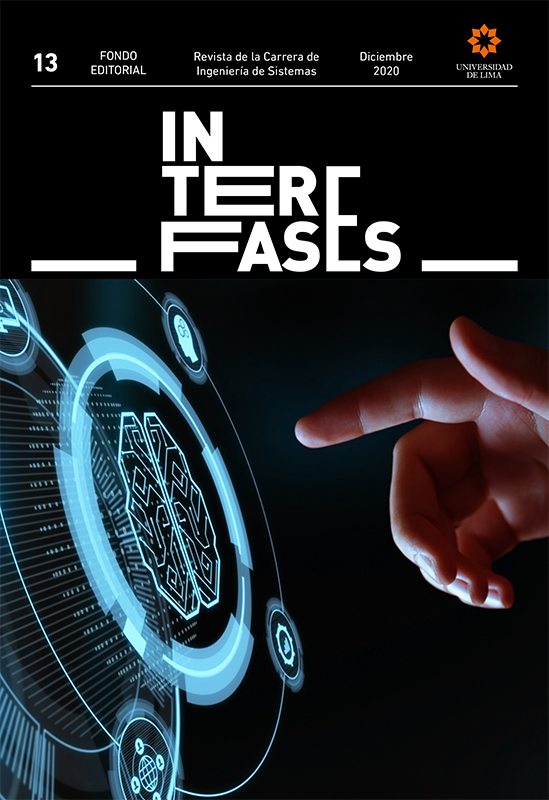Software in the Loop para la implementación de un sistema de piloto automático para aeronaves de ala fija
DOI:
https://doi.org/10.26439/interfases2020.n013.4857Palabras clave:
SITL, piloto automático, aeronaves, ingeniería de software, simulink, PIDResumen
Cuando se desea desarrollar y probar softwares para sistemas complejos, como aviones, transbordadores espaciales, satélites, automóviles o plantas nucleares, uno de los mayores inconvenientes es la gran complejidad, riesgos y costos que implica realizar pruebas sobre el sistema real. Software in the Loop (SITL) permite testear algoritmos, códigos fuente o estrategias de control para sistemas complejos dentro de una simulación que contiene el modelo matemático del sistema físico real. El presente trabajo propone el uso de la plataforma Software in the Loop con el fin de desarrollar un sistema de piloto automático para una aeronave de ala fija. Se muestra la arquitectura de la aplicación implementada, el proceso de diseño de software, los protocolos utilizados, las estrategias de control, técnicas de programación, los resultados obtenidos y las conclusiones.
Descargas
Referencias
Aboelela, M. A. S., Ahmed, M. F., y Dorrah, H. T. (2012). Design of aerospace control systems using fractional PID controller. Journal of Advanced Research, 3(3), 225–232. http://doi.org/10.1016/j.jare.2011.07.003
Akyürek, Ş., Kürkçü, B., Kaynak, Ü., y Kasnakoğlu, C. (2016). Control Loss Recovery Autopilot Design for Fixed-Wing Aircraft. IFAC-PapersOnLine, 49(9), 117-123. http://doi.org/10.1016/j.ifacol.2016.07.509
Astrom, K. J. (2002). PID Control. Control System Design, 216–251. Recuperado de https://www.cds.caltech.edu/~murray/courses/cds101/fa02/caltech/astrom-ch6.pdf
Attya, S. M., y Abdulla, A. I. (2018). PID Controller Design and Simulation for Aircraft Roll Control Based on Evolutionary Technique Using MATLAB, JET, 8(3), 5-9. Recuperado de http://doi.org/10.17605/OSF.IO/UT8FB
Bansal, H. O. (2009). Tuning of PID Controllers using Simulink. International Journal of Mathematical Modeling, Simulations and Applications, 2(3), 337–344. Recuperado de https://www.researchgate.net/publication/268802558_Tuning_of_PID_Controllers_using_Simulink
Coopmans, C., Podhradský, M., y Hoffer, N. V. (2016). Software- and hardware-in-the-loop verification of flight dynamics model and flight control simulation of a fixed-wing unmanned aerial vehicle. 2015 Workshop on Research, Education and Development of Unmanned Aerial Systems, RED-UAS 2015, 115-122. http://doi.org/10.1109/RED-UAS.2015.7440998
Cova, W. J. D. (2005). Control PID, un Enfoque Descriptivo. Universidad Tecnológica Nacional, Facultad Regional La Rioja, Departamento de Electrónica. Recuperado de http://www.frlr.utn.edu.ar/archivos/alumnos/electronica/catedras/38-sistemas-decontrol-aplicado/Publicaciones/Control_PID_Enfoque_Descriptivo.pdf
De Castro, D. F., y dos Santos, D. A. (2016). A software-in-the-loop simulation scheme for position formation flight of multicopters. Journal of Aerospace Technology and Management, 8(4), 431–440. http://doi.org/10.5028/jatm.v8i4.612
Ellingsen, G., y McLain, T. (2017). ROSplane: Fixed-wing autopilot for education and research. 2017 International Conference on Unmanned Aircraft Systems, ICUAS 2017, 1503–1507. http://doi.org/10.1109/ICUAS.2017.7991397
FlightGear. (2020). FlightGEar Flight Simulator. Recuperado de https://www.flightgear.org/
Gouthami, E., y Rani, M. A. (2016). Modeling of an Adaptive Controller for an Aircraft Roll Control System using PID, Fuzzy-PID and Genetic Algorithm, 11(1), 15-24. http://doi.org/10.9790/2834-11121524
Hartanto, S., Furqan, M., Putera, A., Siahaan, U., y Fitriani, W. (2017). Haversine Method in Looking for the Nearest Masjid. International Journal of Engineering Research, (agosto). http://doi.org/10.23883/IJRTER.2017.3402.PD61H
Islam, M. T., Alam, M. S., Laskar, M. A. R., y Garg, A. (2016). Modeling and simulation of longitudinal autopilot for general aviation aircraft. 2016 5th International Conference on Informatics, Electronics and Vision, ICIEV 2016, (diciembre del 2017), 490–495. http://doi.org/10.1109/ICIEV.2016.7760051
Jia, Y.-B. (2020). Rotation in the Space. Iowa State University, 1-14. Recuperado de http://web.cs.iastate.edu/~cs577/handouts/rotation.pdf
Khalid, A., Zeb, K., y Haider, A. (2019). Conventional PID, adaptive PID, and sliding mode controllers design for aircraft pitch control. 2019 International Conference on Engineering and Emerging Technologies, ICEET 2019, (julio), 1-6. http://doi.org/10.1109/CEET1.2019.8711871
Koks, D. (2008). Using Rotations to Build Aerospace Coordinate Systems. Electronic Warfare and Radar Division Systems Sciences Laboratory. Recuperado de https://apps.dtic.mil/dtic/tr/fulltext/u2/a484864.pdf
Korkmaz, H., Ertin, O. B., Kasnakoǧlu, C., y Kaynak, Ü. (2013). Design of a Flight Stabilizer System for a Small Fixed Wing Unmanned Aerial Vehicle using System Identification. IFAC Proceedings Volumes (IFAC-PapersOnline), 1(PART 1), 145-149. http://doi.org/10.3182/20130916-2-tr-4042.00012
Peet, M. M. (2010). Spacecraft and Aircraft Dynamics. Illinois Institute of Technology. Recuperado de http://control.asu.edu/Classes/MMAE441/Aircraft/441Lecture1.pdf
Qays, H. M., Jumaa, B. A., y Salman, A. D. (2019). Design and Implementation of Autonomous Quadcopter using SITL Simulator. Iraqi Journals of Computers, Communications, Control & Systems Engineering, 20(1), 1-16. http://doi.org/10.33103/uot.ijccce.20.1.1
R., R., M., C., S., C., Kumar, P., y N., P. (2020). PID Controller Design for Dynamic Motion of an Aircraft. SSRN Electronic Journal, (mayo), 859-862. http://doi.org/10.2139/ssrn.3511417
Redshift Labs. (2020). Understanding Euler Angles. Chrobotics. Recuperado de http://www.chrobotics.com/library/understanding-euler-angles
Slabaugh, G. G. (2017). Computing Euler Angles from a Rotation Matrix. Digital Environment Research Institute (DERI) Queen Mary University of London, 1-7. Recuperado de https://www.gregslabaugh.net/publications/euler.pdf
Sudha, G., y Deepa, S. N. (2016). Optimization for PID Control Parameters on Pitch Control of Aircraft Dynamics Based on Tuning Methods. Applied Mathematics and Information Sciences, 10(1), 343-350. http://doi.org/10.18576/amis/100136
Surowski, D. (2011). Distance between Points on the Earth’s Surface. Kansas State University, Department of Mathematics. Recuperado de https://www.math.ksu.edu/~dbski/writings/haversine.pdf
Wahid, N., Hassan, N., Rahmat, M. F., & Mansor, S. (2011). Application of Intelligent Controller in Feedback Control Loop for Aircraft Pitch Control. Australian Journal of Basic and Applied Sciences, 5(12), 1065–1074. Recuperado de http://www.ajbasweb.com/old/ajbas/2011/December-2011/1065-1074.pdf
White, M. (2019). PID Control for Robotics. Programming. Recuperado de https://mjwhite8119.github.io/Robots/pid-control
Descargas
Publicado
Número
Sección
Licencia
Los autores/as que publiquen en esta revista aceptan las siguientes condiciones:
Los autores/as conservan los derechos de autor y ceden a la revista el derecho de la primera publicación, con el trabajo registrado con la licencia de atribución de Creative Commons, que permite a terceros utilizar lo publicado siempre que mencionen la autoría del trabajo y a la primera publicación en esta revista.
Los autores/as pueden realizar otros acuerdos contractuales independientes y adicionales para la distribución no exclusiva de la versión del artículo publicado en esta revista (p. ej., incluirlo en un repositorio institucional o publicarlo en un libro) siempre que indiquen claramente que el trabajo se publicó por primera vez en esta revista.
Se permite y recomienda a los autores/as a publicar su trabajo en Internet (por ejemplo en páginas institucionales o personales) antes y durante el proceso de revisión y publicación, ya que puede conducir a intercambios productivos y a una mayor y más rápida difusión del trabajo publicado (vea The Effect of Open Access).
Última actualización: 03/05/21






